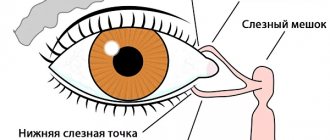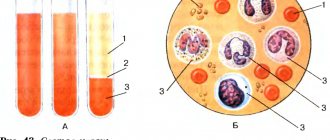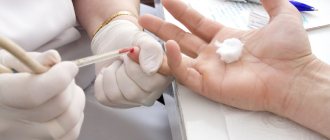The human ear is a self-cleaning organ of hearing. ENT doctors do not recommend deep cleaning. Wax in the ear canal provides protection against infection. The sulfur plugs are washed out by a specialist doctor at the appointment. If you try to remove excess wax on your own, you may find blood from the ear on a cotton swab.
This phenomenon is caused by various reasons and is accompanied by additional symptoms. Bleeding from the auricle looks like a spotting discharge with inflamed mucus, or blood literally flows onto the neck and shoulder.
What can you do at home?
If you have a symptom like this, never try to help on your own. The most correct thing to do is to moisten a cotton swab with a disinfectant (a light solution of potassium permanganate), squeeze it well and loosely tamp the external auditory canal.
Nothing should be instilled, and it is forbidden to take pills until examined by a doctor. At the clinic, notify the receptionist so that you can be admitted for urgent reasons. If your temperature is elevated, your hearing is impaired, or you have a headache, call an ambulance. Requires hospitalization in a specialized department.
Treatment is prescribed after a careful examination of the ear, and if necessary, an x-ray is taken.
All causes of bleeding from the ears can be divided into inflammatory, mechanical and tumors.
How to provide first aid if blood appears from a child’s ear?
If you suspect a traumatic brain injury, place your son or daughter on a flat surface and leave him alone until paramedics arrive. In other cases, you can rinse the damaged area with warm, clean water and treat with an antiseptic composition. Then it is important to make an appointment with an otolaryngologist for the nearest date.
If any object is sticking out of the ear canal, you should not pull it out yourself. Make sure your child doesn't try to do this. Explain to him that the doctor will remove the foreign body himself, and it will not hurt.
Inflammatory ear diseases, symptoms
The ear is connected to the nasopharynx, so any infection in the nose, paranasal sinuses (with sinusitis, frontal sinuses) quickly spreads to the inner ear. In children, more often than in adults, inflammation occurs during a cold, against the background of enlarged adenoids, polyps in the nasal passages.
Acute otitis media
The disease is caused by a viral infection, staphylococci, streptococci, fungi. The severity of the disease depends on the defenses: the weaker the body, the more severe the course. The inflammatory process “corrodes” neighboring blood vessels, ruptures the eardrum that covers the inner parts of the ear from the ear canal, and breaks out along with the serous contents and blood.
Blood discharge from the ear is noticed on the pillowcase in the morning. For purulent otitis media:
- The pain becomes unbearable, it radiates into the throat and covers half of the head.
- Body temperature is increased.
- The hearing on the affected side is impaired.
- The discharge is bloody and purulent with an unpleasant odor.
- Enlarged submandibular and postauricular lymph nodes are palpable.
Characteristic redness of the ear with a boil
Provoking factors for the development of inflammation are:
- hypothermia of the legs and head (in the absence of a hat in the cold season);
- swimming in polluted places;
- prolonged use of headphones to listen to broadcasts;
- chronic infectious diseases in the body (not necessarily ENT organs, carious teeth, adnexitis in women, prostatitis in men are important);
- attempts at hardening by cold dousing;
- decreased immunity due to stress, surgery, or prolonged fasting.
Furuncle of the auditory canal
To protect against dust particles, there are a small number of hairs in the ear canals of the auricle. When an infection is introduced with dirty hands, the hair follicle becomes inflamed, the hole and ear swell.
After pain when touched, constant pain and ear congestion appear. Swelling is palpable. Redness of the hot ear is noted. The boil may open on its own or during treatment. In this case, pus may be discharged with slight bleeding.
Diagnosis and treatment for ear bleeding
Typically, the first doctor to treat a patient with bleeding from the ear is an otolaryngologist. First of all, it excludes all diseases associated with the hearing aid. To do this, the ear is examined using special instruments, CT and MRI are performed.
Severe otitis media is treated in a hospital with powerful antibiotics or antifungal drugs. Surgical procedures are performed, for example, puncture of the eardrum and its dissection to install a tympanostomy tube, which ensures the drainage of pus and exudate and allows the administration of medications.
Foreign objects are removed using special instruments under local or general anesthesia. The boil is opened in the operating room. If an intracranial tumor is detected, the patient is treated in a neurosurgical hospital. In case of bleeding of unknown cause, hemostatic therapy is carried out before identifying the underlying pathology. The patient is always consulted by a neurologist and neurosurgeon. If necessary, emergency surgery is performed with the participation of several specialists.
If a child has bleeding from the ear, he must be urgently taken to the emergency department of a multidisciplinary hospital.
If blood is flowing from the ear, then you need to remember that the time factor in some injuries determines the prognosis of the disease and the functional state of the hearing aid. Especially if the bleeding is associated with injury or bruise, or rupture of the eardrum.
Mechanical reasons
The easiest way to find out why the victim's ear is bleeding is to examine it after washing it with a warm soapy solution. A common symptom of mechanical damage during fights is abrasions and cuts on the auricle. After a blow, the ear may be red and swollen. The bruising extends to the cheekbone. Induration and pain are determined by palpation.
A lacerated wound to the auricle will require local treatment
Children's attempts to push small objects into their ears should be taken seriously. Such injuries are not just associated with abrasions, but can disrupt the tympanic septum and penetrate into the middle ear. The patient experiences bleeding from the ear canal due to severe pain.
If a victim in an accident bleeds from the ear, one should suspect fractures of the skull bones with the formation of an acute hematoma.
Due to the accumulation of blood in the cranial fossa, bleeding may be delayed. The patient has headaches, dizziness, and tinnitus. The condition is progressively worsening. Bleeding from the ears and nose confirms the severity of the injury. Loss of consciousness and convulsions are possible.
Another type of mechanical impact occurs when divers quickly dive or accelerate their ascent. The eardrum cannot withstand the pressure difference and is injured. Ear bleeding is one of the symptoms of decompression sickness.
Treatment options for bleeding from the ear
The otolaryngologist's actions depend on how serious the case is. If there is a suspicion of a ruptured eardrum or ear cancer, additional diagnostic tests will be required, including CT and MRI. Additional consultations with a therapist, neurologist, neurosurgeon or oncologist will also be required.
In other cases, the otolaryngologist provides assistance independently. If there is a foreign object in the ear, the doctor carefully removes it and treats the damaged area. If the bleeding is caused by a disease, the otolaryngologist prescribes antibacterial, antifungal, and painkillers. It is important to start treatment as soon as possible to prevent other symptoms from developing. This way, the baby will not experience hearing loss and headaches, so he will be able to recover as soon as possible and return to active games with peers.
Ear pain due to diseases of other organs
- Mastoiditis - inflammation of the mastoid process - causes intense throbbing pain in the ear, swelling of the tissue behind the auricle, hearing loss, and hyperthermia.
- With arthrosis and arthritis of the temporomandibular joint, the patient is bothered by shooting pains in the ear, which intensify when chewing, a crunching sound in the temple area, and over time, hearing impairment and malocclusion are possible.
- Mumps is an inflammation of the salivary gland located in front of the auricle, accompanied by acute pain in the ear, aggravated by swallowing and chewing, and swelling of the tissues.
- Inflammation of the parotid lymph nodes (lymphadenitis) develops when infection penetrates into them from diseased teeth or from other foci of inflammation.
- Inflammatory diseases of the nasopharynx and sinuses, malignant processes in the larynx and oral cavity are often accompanied by pain in the ear when swallowing.
- Caries, pulpitis. Since the organ of hearing, like the teeth, is innervated by the branches of the trigeminal nerve, damage to the teeth and jaw may be accompanied by pain in the ear area.
- An atypical form of heart attack, when the patient’s only subjective complaint is pain in the ear.
Otitis externa
Most often, inflammation of the outer ear is bacterial in nature.
The causes of infection may be:
- trauma to the external auditory canal, for example, from a sharp or blunt object, or from a hearing aid;
- skin defects due to eczema, psoriasis, diabetes and other diseases;
- too thorough removal of earwax, which creates an acidic environment that prevents the growth of microbes;
- frequent entry of water into the outer ear (“swimmer’s disease”).
Symptoms of external otitis:
- acute ear pain, aggravated by pressing on the tragus or pulling the earlobe;
- possible itching and a feeling of “stuffiness” in the ear;
- discharge of a purulent or bloody nature, sometimes having an unpleasant odor;
- examination reveals swelling and hyperemia of the external auditory canal;
- possible hearing loss;
- enlargement and tenderness of the lymph nodes in the neck and behind the ear on the affected side.
The course of the disease may be complicated by a perforation of the eardrum, which cannot be determined without a visit to an ENT specialist.
External otitis of fungal origin is a common phenomenon, usually occurring in patients with low immune status or due to long-term use of antibacterial drops. It is characterized by severe itching, the formation of crusts, profuse thick discharge and the absence of a therapeutic effect from the use of antibiotics.
Separately, it is worth noting the localization of a boil on the skin of the external auditory canal or inflammation of the atheroma. The clinical picture is similar to otitis externa, but upon examination there is a more localized focus of inflammation with an opening from which pus and blood can be discharged.
Types of bleeding
Depending on the origin of bleeding, there are three main types:
- Arterial. Observed as a result of sudden changes in pressure.
- Venous. The reasons for this type of ear bleeding lie in mechanical damage.
- Capillary. Occurs with any damage to the hearing aid, including minor ones. Such bleeding is often light. It can be easily stopped without seeking medical help. This type includes nosebleeds, shallow cuts to the skin, and so on.
Any bleeding can cause serious health problems. Excessive blood loss causes anemia and threatens the child’s life. Therefore, if such a symptom occurs, you should immediately seek help from a doctor.
Treatment
Treatment of inflammatory ear diseases includes:
- antibacterial, antiviral agents of local and general action;
- antipyretics, analgesics;
- physiotherapy;
- in some cases - surgical intervention.
Treatment must be based on accurate diagnosis, which is impossible outside a specialized clinic. The high professionalism of CELT specialists allows us to identify various diseases of the hearing organ and choose the most effective means of solving the problem.
Make an appointment through the application or by calling +7 +7 We work every day:
- Monday—Friday: 8.00—20.00
- Saturday: 8.00–18.00
- Sunday is a day off
The nearest metro and MCC stations to the clinic:
- Highway of Enthusiasts or Perovo
- Partisan
- Enthusiast Highway
Driving directions
What it is?
Otitis media is an inflammatory disease that occurs in different parts of the auricle and is classified into:
- External - the mildest form of otitis, which is easy to notice, occurs in 25% of people.
- Medium is the most common type of otitis, inflammation of the elements of the tympanic cavity, accounting for about 65% of cases. Diagnosed quite easily.
- Internal - with an advanced stage of an infectious disease from the middle ear, it moves to the internal part, affecting 10% of the population.
It can occur in acute or chronic form.
The acute form of otitis is a severe inflammation that occurs with pain in the ear, which is quickly treated.
Chronic - characterized by a long course of this disease, with periodic inflammations and exacerbations.
Preventive methods
To prevent bleeding from the ear, you need to follow a few simple rules:
- promptly treat diseases of the ear, nose and throat;
- prevent chronic processes in the body;
- perform various actions aimed at increasing immunity (physical education, hardening);
- do not allow water to stagnate in the ears after a bath or swimming in ponds;
- do not use sharp objects to clean your ears;
- avoid places with very high noise levels;
- To remove wax plugs, visit an ENT doctor’s office.
To prevent injuries at work, you should protect your head and follow safety precautions.
Structure of the hearing aid
The hearing aid is a complex system that is responsible for a person’s ability to hear sounds. Bleeding can occur in any part of it. Therefore, before finding out the cause of the problem, it is necessary to understand the structure of the organ. It is usually divided into several main zones:
- External part . Consists of the auricle and ear canal. Its main function is to receive the sound signal and direct it to the middle part of the system. The auditory canal is tortuous. It consists of the helix, tragus, antihelix, antitragus. Its surface is lined with a specific fabric. Inside it are glands that produce a secretion that protects the ear from infectious, thermal and mechanical damage.
- Middle part . It includes the auditory tube and the tympanic cavity. Its key task is the transmission of vibrations. This becomes possible thanks to the system of tiny bones that make up the eardrum.
- Inner part . Represented by the vestibular analyzer. With its help, the body manages to maintain a given position in space; it also helps regulate all human movements.
All parts of the auditory organ are very sensitive and easily damaged. This is especially pronounced in childhood, since the immune system of children does not function at full strength and is not able to protect itself from the effects of negative factors.
Diagnostics
The diagnosis and treatment of pathologies associated with this symptom is carried out by an ENT doctor (otorhinolaryngologist) or an audiologist (a narrower specialty in otorhinolaryngology). During the appointment, the specialist talks with the patient, examines him, conducts the necessary examination, and establishes a diagnosis.
The multidisciplinary CELT clinic employs experienced, highly qualified otolaryngologists. Rich clinical experience helps them make the correct diagnosis in the most difficult cases.
Treatment methods
Treatment of a symptom directly depends on the cause of its development. A patient complaining of malaise will need to be examined in the office of an otolaryngologist, since this specialist deals with ear pathologies.
Ear examination
Diseases of the hearing organ that are accompanied by bleeding are usually treated with medication. With this diagnosis the following are prescribed:
- Antimycotic drugs;
- Antiseptics;
- Systemic antibiotics;
- Anti-inflammatory drugs.
It is highly undesirable to use any medications without first consulting a doctor.
If the symptom is a consequence of the development of a benign or malignant neoplasm, then the patient will have to agree to surgery to remove the tumor body. For this purpose, doctors refer patients to the following procedures:
- Radio wave therapy;
- Laser therapy;
- Electrocoagulation;
- Cryodestruction.
If the problem is caused by injury to the hearing organ, then periodic treatment with an antiseptic is sufficient. Such injuries usually do not require special treatment, as they heal on their own.
Diagnosis of the problem
The doctor conducts a tactile and visual examination and, if necessary, performs an otoscopy , which will identify any damage in the ear.
If chronic purulent otitis is suspected, differential diagnosis of epitympanitis from mesotympanitis using X-rays and computed tomography . fluid samples will be taken for analysis. Thanks to research, the doctor can:
- determine the presence of inflammation in the hearing organ;
- identify the exact causative agent of the infection;
- determine the stage of the process;
- find out if there are any complications.
After making a diagnosis, the doctor will prescribe effective medications.











